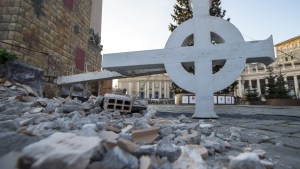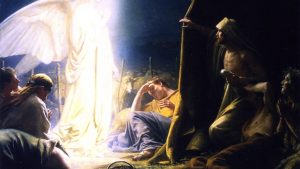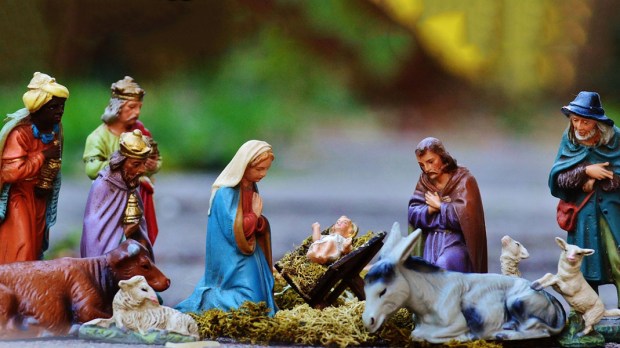Often neglected in the media, the Nativity scene holds far more importance than the popular Christmas tree. Yet do you know the rich meaning behind both of these cherished Christmas symbols? Here’s a brief explanation with a few reasons why you need to pay extra attention to your creche this year:
The symbolism of the tree
Today’s beautifully decorated Christmas trees are little like the first trees used by Christians to celebrate Christ’s birth all those centuries ago. Back in the 8th century, during his missionary in Germany, St. Boniface chopped down a sturdy oak tree, much to the amazement of the Druids who used it as a symbol of worship. Turning to a small fir tree, St. Boniface referred to it as the “tree of the Christ-child,” with its everlasting pine needles; a sign of eternal life. The triangular shape also helped to symbolize the Holy Trinity, and its green branches pointed upward to heaven. He instructed the Germans to “gather about it … in your own homes; there it will shelter no deeds of blood, but loving gifts and rites of kindness.”
As Christmas trees became popular, there was concern about the pagan character of its origin, but the symbolic meaning behind the tree demonstrated its deep roots in the Christian faith. In fact, the symbolism of the tree is very rich in our tradition: our forebearers were directed by God not to eat the fruits of one of the trees of Eden; Christ paid the highest price of our redemption crucified on a tree trunk; the green branches and the lights that decorate the Christmas tree evoke Christ as the Eternal Light that comes to a world enveloped in darkness.
Despite the strong commercial nuances over the last century, diminishing its Christian significance for many, the Christmas tree remains a valid symbol of the coming of Christ into the world. So while decorating the tree, why not use it as a time to explain to your children the story of one of the greatest missionaries, St. Boniface, and how the humble fir came to represent such an important event?
The history of the Nativity scene
However, even with this contextual validation, the Christmas tree is by no means the main visual symbol of the birth of Jesus. This is when we need to turn to another saint, the beloved St. Francis of Assisi, who while traveling in Grecio, Italy back in 1223, created the first crib in history when trying to solve the problem of over-crowding in a church at Midnight Mass.
Finding a little niche in a rock, St. Francis set about making an altar. He gained permission from the pontiff to create a living crib, with the village inhabitants representing the Child Jesus in the manger, Our Lady, St. Joseph, the Magi, the shepherds, and the angels. The animals were also real: the ox, the donkey, and the sheep. St. Bonaventure describes St. Francis at the scene: “The man of God [St. Francis] stood before the manger, full of devotion and piety, bathed in tears and radiant with joy.” News of the crib soon spread, turning into the beautiful Christmas custom it has become today, with carved cribs becoming popular in the churches around the 16th century, thanks to the evangelizing work of the Jesuit priests.
When building the creche, there are lots of meanings and traditions to stick to at various stages. Here are some for you to add to your own family tradition:
How to prepare the crib in meaningful stages
- First, organize the general scene, placing the animals, the shepherds, the manger – but hold off adding the main characters of Jesus, Mary and Joseph, the angels, the star, and the three kings.
- Some families wait until the afternoon of December 24 to place the crib and the figurines of the Blessed Virgin Mary and Saint Joseph, but still refrain from adding Infant Jesus – sometimes difficult with impatient kids!
- Disclosure: the manger remains empty until midnight, when, symbolizing the Birth of the Son of God, the image of the Child is finally placed there!
- Along with baby Jesus, the angels are also placed, who evoke the song “Glory to God in the highest and peace on earth to men of good will,” mentioned in the Scriptures.
- Together with the angels, add the star that guided the three kings from the East to Bethlehem to worship the Savior, on top of the crib. The magi, popularly referred to as Gaspar, Melchior, and Balthazar, represent all the peoples of the earth and often come with their trusty exotic rides: camels or even elephants.
- There are those who begin to position the three kings in the crib only from the 25th onward: initially they are placed far from the manger, still traveling, and are approached a little more each day until they arrive on the feast of the Epiphany, on January 6.
A true domestic catechism
However, the crib is not a simple adornment: it is a beautiful visual form of expressing our faith and our prayer, during the waiting and celebration for the arrival of the Savior. This tradition involves a process, a growth, and an exciting time for the family in preparation of the most beautiful story of all time. It is a true domestic catechism, especially for children!
Resistance to forced secularization
With the increase in forced secularization, which has completely distorted the meaning of the Christmas tree (and of Christmas itself), it is far more difficult to erase the explicit symbolism that is present in the Nativity scene, since the reference to the Savior is blatant and obvious. Perhaps this is why in modern times the crib has simply been ignored, to the extent of gradually being forgotten — in a few cases, it is treated as “tacky” or in “bad taste”… or worse: there are cases in today’s Western world where local councils have even banned the crib in areas visible to the public, in order not to “offend” the followers of other religions. It would be a pity that Catholic families also find themselves “forgetting” the crib and its most wonderful symbolism of the beginning of Christ’s life on Earth.
So get into the attic, dust off your manger, and make room in your house for the crib this year, with a thought to St. Francis of Assisi.

Read more:
Vatican Nativity scene includes cross from Basilica of St. Benedict in Norcia

Read more:
The Rage of Hell, the rejoicing of Heaven: What the shepherds saw

